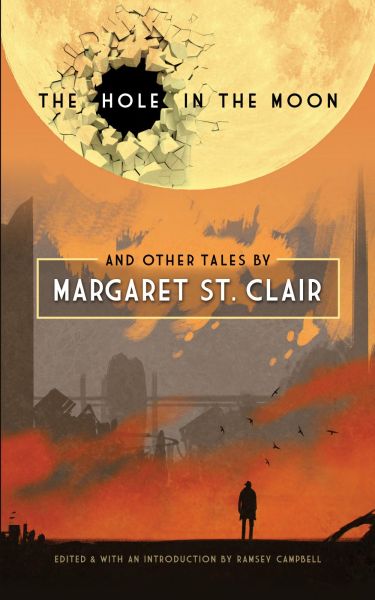I Believe in Yesterday
The Hole in the Moon and Other Tales
By Margaret St. Clair

2 Sep, 2021
0 comments
2019’s The Hole in the Moon and Other Tales is a collection of short stories by Margaret St. Clair.
While the collection itself is recent, and although the author lived until 1995, almost all of the stories were first published in the 1940s or 1950s. This is because only a small fraction of St. Clair’s short fiction post-dates 1960. Like many of her colleagues, St. Clair shifted her focus to novels after 1960, perhaps due to changes in the SFF publishing industry.
St. Clair fans who previously purchased The Best of Margaret St. Clair and/or Change the Sky and Other Stories should be aware there is some overlap: “The Gardener,” “Child of Void,” “Hathor’s Pets,” “The Causes,” “Brenda,” and “The Invested Libido” appeared in The Best of Margaret St. Clair, while “Stawdust” appeared in Change the Sky and Other Stories.
What’s striking about the collection is the author’s embrace of a wide range of genres and the skill of her prose. The standout story may be her “The Little Red Owl,” which is horrifying not because of anything supernatural, but because humans act like humans do.
The Hole in the Moon and Other Tales is available here (Amazon US), here (Amazon Canada), here (Amazon UK), here (Barnes & Noble) and here (Book Depository). I did not find it at Chapters-Indigo.
Drilling down a level:
Introduction (The Hole in the Moon and Other Tales) • essay by Ramsey Campbell
A rather half-hearted introduction that gives away enough about each story I’d leave it until last. Or skip it entirely, as it is the weakest part of the collection.
“Rocket to Limbo” • (1946)
Trapped in a loveless marriage to a subpar spouse, a self-centered housewife resorts to extreme measures to rid herself of her unwanted husband. What could possibly go wrong?
There are a fair number of SFF stories about people trapped in unhappy marriages. On an unrelated note, depending on the state, no fault divorces were not available to Americans until anywhere from 1970 (California) to 2010 (New York).
“Piety” • (1947)
Humans fail to discover the secret behind alien immortality.
But only because the aliens are needlessly obscure in their phrasing.
“The Hierophants” • (1949)
Space castaways discover an alien Garden of Eden, a paradise both irresistible and deadly.
The alien Garden of Eden is similar enough to the paradise of human myth that it seems familiar and safe, even though it is sufficiently different that visitors suffer lethal side effects.
“The Gardener” • (1949)
An obnoxious bureaucrat, secure that his position elevates him above local regulation, commits an egregious sin. His faith in his personal immunity is very misplaced.
“Child of Void” • (1949)
While taking refuge on an uncle’s estate, a mother and her children become Earth’s defense against malevolent dimensional invaders.
“Hathor’s Pets” • (1950)
Humans successfully convince their alien captor that the humans are more trouble than they are worth. The results are not the ones they desired.
“World of Arlesia” • (1950)
Would-be vacationers narrowly escape a cutting-edge distraction from daily woes.
“The Little Red Owl” • (1951)
A sadist devotes himself to breaking the wills of two children unfortunate enough to fall into his care. He discovers all too late that he has woefully underestimated their resources.
“The Hole in the Moon” • (1952)
A lonely pandemic survivor is forced by a vision to decide whether certain death is worse than unending isolation.
“The Causes” • (1952)
An encounter in a bar gives a mortal some disquieting updates on divine activities.
“Island of the Hands” • (1952)
A bereaved widower searching for his aviatrix wife’s body discovers a land where dreams can be granted … at a price.
“Continued Story” • (1952)
Pursued by a narrative written by sadists, a seeming madman finds escape by directing his stalker’s attention to a brand-new protagonist.
“Brenda” • (1954)
A social outcast girl discovers unexpected common ground with a monstrous being.
“Stawdust” • (1956)
Trapped on a starship whose passengers and crew are being horrifically transformed, a jaded traveller discovers too late the cause of the malady.
“The Invested Libido” • (1958)
Encouraged to truly find himself, a mental patient instead finds someone else.
“The Autumn after Next” • (1960)
An evangelical wizard’s attempt to inspire his charges to magical professionalism run aground on their sloth and sloppiness. Alas for the wizard, small errors have large consequences.
“The Sorrows of Witches” • (1979)
Her true love slain by a jealous rival, the sorceress turns to necromancy to regain her lover. Results are mixed. He is restored to, if not life, then activity, but happiness eludes the sorceress.
